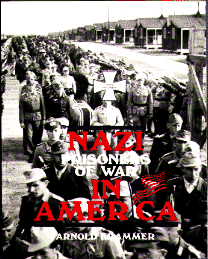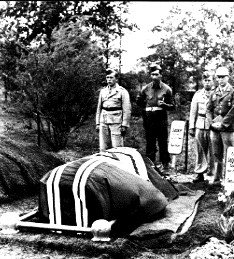Do As I Say, Not As I Do
A column in the June 16, 1996 edition of the Orange County (California) Register, recounted details of the desecration of a grave. It's an oddly common crime (or so some say) but this one had a twist. You might even say a warp.
Across a busy thoroughfare from a little unincorporated area called Midway City, there's a large mortuary and cemetery that, in true Southern California style, also serves as a wedding chapel and “family picnic” facility. Plant the ex, marry the replacement and have a party, all in one convenient location. Plenty of parking, 7-11 store just across the street. Midway City is an anachronism, an old neighborhood surrounded completely by incorporated cities, stubbornly hanging on to its gritty past. It lies at the edge of a burgeoning Vietnamese community called Little Saigon.
A week earlier, a woman who lives in Midway City finally gave in to an uncontrollable impulse of hate, entered the cemetery grounds, and destroyed an offending grave marker there. She had seen it several times through the fence while walking by. A swastika, right in plain sight, an intolerable affront to the sensibilities of any decent person.
After she committed this crime, it was initially written up by columnist Bill Johnson in a manner that struck some as sympathetic to the act. Then the twist came to light. Quoting from his column of June 16:
“Van. Van. Van. Van. …
I have been up at the blackboard for more than 24 hours now, and I can't go back to my desk until I write it another hundred times. It's to teach me, once and for all, the difference between the hated symbol of the National Socialist Party of Germany and the ancient Buddhist religious sign meaning 'enlightenment.'
Van. Van. Van. Van. …
Of course, I am not serving out a sentence at a blackboard. It just has felt that way the past few days since I wrote here of a Midway City woman who spotted a Buddhist swastika in a Westminster cemetery, mistook it for a Nazi swastika, and destroyed it.
Scores of people have written and telephoned to say it likely was a van that was destroyed, and not the German swastika. Some said the column condoned grave desecration. That is nonsense. Others called to point out the woman's likely mistake. And that's what I truly think it was. …”
A mistake. Well, of course! Glad we got that settled right off the bat. For a minute there you'd think it was a crime of malicious vandalism fueled by hate. It would have been perfectly OK to desecrate a grave with a German swastika on it, but this was a mistake. Thank God it wasn't a German Buddhist who was buried there, else we might never have gotten the moral points sorted out.
* * *
About 5 years ago, a mentally disturbed transient in the L.A. area made a mistake too. His mistake was in painting a swastika on the door of a synagogue and getting caught. Hauled up before a righteously indignant judge, he pled guilty and wanted to make a pre-sentencing statement, but the judge literally wasn't hearing it. This sad sack of cheap wine and schizoid neural connections was handed a twenty month sentence in state prison. Not a local country club county facility, but the Big House.
You wonder if it would have affected his sentence if the unallowed statement revealed that maybe he was painting a van on the door in order to offer the congregation enlightenment?
You wonder too how many other cases of mistaken identity have led to irreparable desecrations of people's lives? People like British historian David Irving, a best selling author many times over; lionized by the academic community for his prodigious research of original sources, uncovering material that might have eluded our store of knowledge forever had he not possessed the dogged determination and keen insight which are his trademarks. But Mr. Irving had the misfortune of drawing the wrath of the ADL who, like the bigoted woman in Midway City, were certain that they had spotted a Nazi swastika on his head and know exactly how to handle such things. Smash them, by God! The vicious campaign of belittlement, character assassination and boycotting that they mounted has left the future of Irving's latest work (seven years in the writing) and indeed perhaps his career as a bestselling author, in ruins, exactly like the shattered van. The van can be replaced, an act of atonement that Mr. Johnson participated in for his part in this excused “hate crime.” But how do you restore a man's tarnished reputation after he's been held up as a “hater” to millions of people around the world? You don't, and therein lies the real crime of these sorry exercises in bigotry masquerading as righteousness.


At left, funeral for Gen. Hans Schubert. Right, burial in Camp Robinson, Arkansas, 1944.
Source: “Nazi Prisoners of War in America,” Kammer, ISBN 0-8128-8526-0
Over a half-million German prisoners of war were held in labor camps across the United States in World War II. As the photographs show, they were allowed to display political symbols of their country (including the swastika) not only at burials but on a regular basis. This was not a sign of tender feelings about the prisoners either—there was great animosity toward them on the part of many of the American guards and the clearly xenophobic American public. At that time their symbols had not yet acquired the taboo status which decades of relentless demonization by the media would impart, and this simple recognition of a basic human need (to identify with one's group) was accorded to them as readily as other givens, such as decent food and shelter. It did not seem odd at the time to acknowledge the validity of patriotism on the part of an enemy, regardless of the level of disagreement with political philosophy (while symbols were allowed, political discussions were not).
These domestic POWs were far more fortunate than their counterparts in Europe, who were kept in open fenced compounds without shelter through a brutal winter, on a literal starvation diet. (Other Losses, James Bacque)
Bibliographic information about this document: Orange County (California) Register, June 16, 1996
Other contributors to this document: n/a
Editor’s comments: n/a
